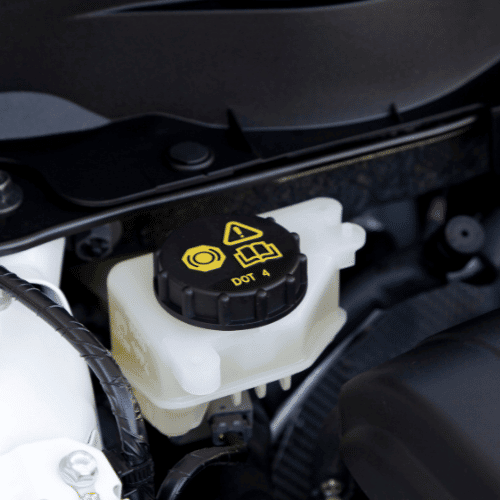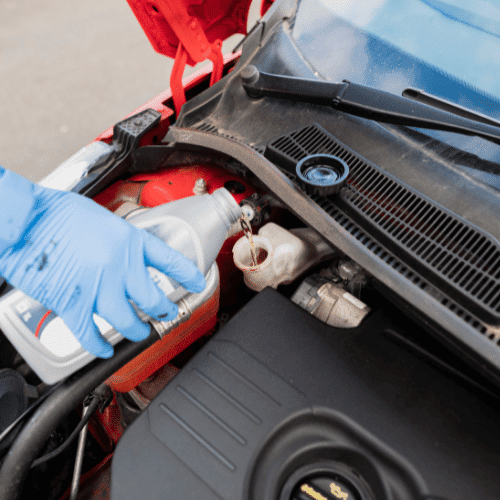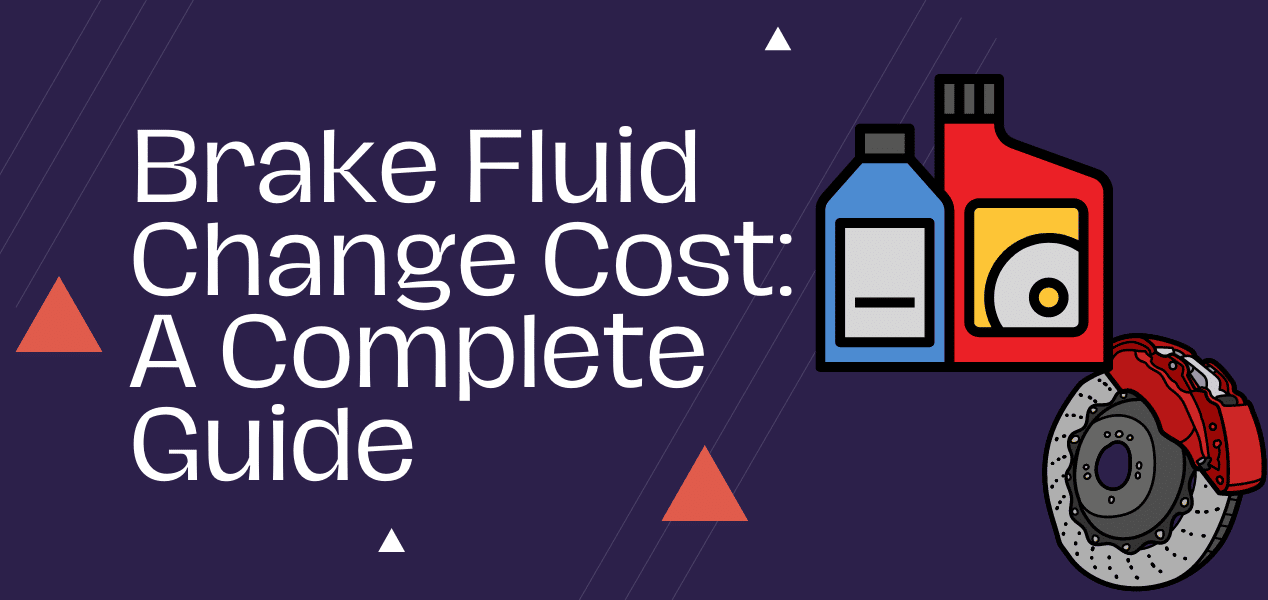Over time, brake fluid either dries up or becomes full of water molecules or other components. This is why it’s important to change the brake fluid after a certain period. So, how much does brake fluid replacement cost?
On average, the cost may be around $17. The cost of brake fluid change can vary from one supplier to another. While some suppliers can charge you as high as $100, there are some who’ll get it done for you absolutely free of charge!
How Much Does Changing Brake Fluid Cost?
On average, a brake fluid change will cost around $17.
The cost of brake fluid change can vary from one supplier to another. While some suppliers can charge you as high as $100, there are some who’ll get it done for you absolutely free of charge.
Brake Fluid Change Cost Breakdown
Let’s break down the brake fluid change cost now. The price of fresh brake fluid doesn’t vary much from supplier to supplier. Depending on the quality of the brake fluid, you can expect to pay anywhere from six dollars to forty dollars at max.
The majority of the expenses will go after the labor costs. As we’ve discussed earlier, while some suppliers can charge you up to a hundred dollars, some will do it for free.
Then again, not every car uses the same brake fluid. A vast majority of cars use DOT 3, but some vehicles use DOT 4. So, the cost will also vary based on the car you’re using.
Factors that Determine the Price of Brake Fluid Change Cost
Previously, we’ve shared that there are certain factors that’ll help you answer how much it costs to change brake fluid. In this section, we’ll take a detailed look at each factor.
Model of the Vehicle
There are multiple reasons why the price may vary depending on the model of your vehicle. Firstly, mechanics tend to charge different rates for luxury cars. If you have a luxury car, get ready to pay more.
Secondly, if the brake fluid pressure bleeder of your car is hard to reach, then you’ll have to pay a higher rate than usual. Usually, these two factors affect the fluid changing costs significantly.
Fluid Cost
As discussed before, the fluid cost will not take up a massive percentage of the total cost. However, it’s still important to consider because brake fluids come in all sorts of price ranges.
You will need only a single quart of brake fluid each time, so we’ll share the price per quart of new brake fluid. If you want to cheap out, you can get brake fluids for as low as $2. However, these will get dirty very soon, so we don’t recommend these.
Then again, it’s not necessary to get super expensive brake fluids unless your vehicle really demands so. Thankfully, most mechanics will be able to guide you through which brake fluid will serve you best.
Most cars use DOT 3 brake fluid. These are hydrophobic, so they require a change every three to five years. DOT 4 brake fluids are essential for performance cars as they can have a higher boiling point. However, these must be changed frequently due to their lower boiling point.
Finally, there’s DOT 5 brake fluid. These are silicone-based brake fluids. You could also go for DOT 5.1 brake fluid. These are a bit unique as they are partially synthetic only. However, the most expensive type of brake fluid is the synthetic one.
As for non-synthetic ones, the DOT 3 is the cheapest. But their price differences aren’t very notable. The most expensive brake fluid costs around $40. However, you may have to spend more depending on the dealer’s markup.
Labor
Lastly, there’s the labor cost, which makes up most of the expenses. This is why a lot of people prefer to change the brake fluid by themselves to save money.
The high labor cost is completely justified as one has to remove all four wheels to access the master cylinder. Although the hourly rate for mechanics is $60, mechanics may charge more or even less depending on where you are.
When Should You Change Brake Fluid?
This brings us to our next question, when should you change the brake fluid? This process is often referred to as brake fluid flush, as the first step involves flushing the old brake fluid out. Generally, the duration differs from manufacturer to manufacturer.
Moreover, the duration can change depending on the specific model and the one driving it. If a vehicle is driven with care and is maintained often, it can go without a brake fluid replacement for three to five years.
Thankfully, there’s an easy way of determining if you need to change brake fluid or not. The brake fluid reservoir is transparent, and you can easily monitor the condition of the brake fluid.
The trick is to check the brake fluid’s condition whenever you’re performing regular maintenance. In good condition, the fluid can either be yellow or transparent. If it starts turning dark brown or black, you should get it replaced.
Another pointer should be the amount of brake fluid level remaining. If the fluid level is low even when the color looks okay, then there’s a leak in the brake fluid reservoir. In such cases, you’ll need to replace the reservoir as well.
One thing to note is that you shouldn’t keep the reservoir open for too long. The longer you keep it bare, the more chances you’re creating for contaminants to enter.
How to Understand that Your Vehicle Requires a Brake Fluid Change?

In this section, we’ll discuss certain factors that’ll help you understand if you have to flush brake fluid or not.
Changing after a Certain Period
Most manufacturers instruct to change the brake fluid every two years. However, mileage is also an important factor. It’s better to change brake fluid as soon as your vehicle hits 30,000 miles.
However, this can vary from one vehicle to another. Certain vehicles, if driven carefully and irregularly, can go on for ten years without resulting in bad brake fluid.
Still, we recommend following the manufacturer’s instructions, as driving with dirty brake fluid can harm other important components.
Depressing the Brake Pedal All the Way
Brakes should activate even with a soft press on the brake pedal. If your brakes have a squishy feeling and you have to depress the brake pedal all the way to the ground, then chances are that your brake fluid requires a change.
This is usually triggered by two things. Firstly, you may have water in your brake fluid. Secondly, there’s a leak that’s preventing the hydraulic pressure from building up.
ABS Light Turns On
The ABS light turns on when there’s a potential problem with the braking system. Although this light doesn’t refer to a brake fluid problem only, it’s worth checking the fluid level out when it turns on.
Burning Smell
This may go unnoticed for some time as you won’t get the smell from inside your car. When performing maintenance or cleaning, you may get a burning smell. This mainly occurs because the boiling points of brake fluids decrease when they get dirty, so they vaporize, forming air bubbles.
Pumping the Pedals for Maximum Power
If you have to pump the pedal all the way for maximum braking power, then there’s a chance that the brake fluid has absorbed moisture from the air inside the system.
How to Change Brake Fluid by Yourself?

If you want to save some cash by changing the brake fluid yourself, then this section is for you. We’ll discuss the process step-by-step for your convenience.
What You’ll Need
- Gloves
- Jack stands
- Floor jack
- Lug wrench
- Hand pump or turkey baster
- New brake fluid
- Oil pan
- Wrench set
- The Process
The Process
Start off by finding the master cylinder under the hood. Take the valve off but before that, wrap some cloth around it so the fluid doesn’t spill. Pump the liquid out with the hand pump and store it in a bottle or oil pan. There will be some leftovers, but that’s okay.
Then, refill the cylinder up to the brake lines. Then, it’s time to initiate the bleeding process, and you’ll need an extra pair of hands for this. Just take the rear wheels apart and open the bleed valve. Ask the other person to press the brake pedal, and you should open the valve right when the pedal hits the ground.
This process has to be repeated with all the brake calipers. Now, top the brake fluid off, and you’ve successfully completed the oil change! If you can’t find the calipers, resort to the owner’s manual.
With the brakes flushed, take the car out for a test drive and try the car’s brakes out.
Conclusion
The brake fluid change cost varies slightly from one dealer to another, but you can reduce it greatly by doing it yourself. That being said, it’s not an easy task, so you shouldn’t do it unless you have prior experience in disassembling your vehicle.
An amateur who takes on this process might just cause further damage, the fix of which will require the attention of a professional mechanic. So, for beginners, we recommend spending the relatively low brake fluid flush cost on a mechanic so you may avoid paying a greater sum.

